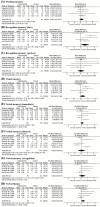Effectiveness of transcutaneous electrical nerve stimulation in improving cognitive function in older adults with cognitive impairment: a systematic review and meta-analysis
- PMID: 40337170
- PMCID: PMC12056508
- DOI: 10.3389/fneur.2025.1556506
Effectiveness of transcutaneous electrical nerve stimulation in improving cognitive function in older adults with cognitive impairment: a systematic review and meta-analysis
Abstract
Background: Transcutaneous electrical nerve stimulation (TENS), which involves the application of electrical stimulation to peripheral nerves, is used to improve or maintain cognitive function. Although many studies have examined the effect of TENS on cognition over the past 20 years, a comprehensive review and meta-analysis on this topic is lacking. This study aimed to evaluate the efficacy of TENS in improving cognitive function in older adults with cognitive impairment.
Methods: A systematic search was performed in six electronic databases (CINAHL, Cochrane Library, Embase, Medline, PubMed, and Web of Science) to identify relevant studies published until May 2024. Moreover, the registered clinical trials, forward citation searches, and reference lists of identified publications were reviewed to identify additional relevant studies. Randomised controlled trials investigating the effect of TENS on cognitive function in older adults with cognitive impairment were included.
Results: Seven studies including 247 older adults with cognitive impairment were included. The findings revealed a trend towards positive effects of TENS on face recognition memory [mean difference (MD) = 1.19, 95% confidence interval (CI) = -0.13 to 2.52] and verbal fluency [standardised MD (SMD) = 0.29, 95% CI = -0.01 to 0.59] when compared with placebo stimulation (control condition). TENS demonstrated a significant positive delayed effect on visual memory (SMD = 0.55, 95% CI = 0.11 to 0.98). Subgroup analysis indicated that TENS applied on the concha was more effective than that applied on the spinal column and earlobe in improving verbal memory in the delayed condition.
Conclusion: A positive trend of immediate effect and a significant long-term effect on some cognitive domains were found after applying TENS in in older adults with cognitive impairment. Future studies with robust experimental designs and adequate sample sizes are warranted to investigate the efficacy of TENS in improving cognitive function.
Systematic review registration: https://www.crd.york.ac.uk/PROSPERO/view/CRD42023408611, PROSPERO: CRD42023408611.
Keywords: cognitive function; cognitive impairment; meta-analysis; older adults; transcutaneous electrical nerve stimulation.
Copyright © 2025 Chan and Ng.
Conflict of interest statement
The authors declare that the research was conducted in the absence of any commercial or financial relationships that could be construed as a potential conflict of interest.
Figures





Similar articles
-
The clinical efficacy of transcutaneous electrical nerve stimulation (TENS) for acute and chronic pain: a protocol for a meta-analysis of randomised controlled trials (RCTs).BMJ Open. 2019 Oct 28;9(10):e029999. doi: 10.1136/bmjopen-2019-029999. BMJ Open. 2019. PMID: 31662366 Free PMC article.
-
Computerised cognitive training for 12 or more weeks for maintaining cognitive function in cognitively healthy people in late life.Cochrane Database Syst Rev. 2020 Feb 27;2(2):CD012277. doi: 10.1002/14651858.CD012277.pub3. Cochrane Database Syst Rev. 2020. PMID: 32104914 Free PMC article.
-
Effects of Electronic Serious Games on Older Adults With Alzheimer's Disease and Mild Cognitive Impairment: Systematic Review With Meta-Analysis of Randomized Controlled Trials.JMIR Serious Games. 2024 Jul 31;12:e55785. doi: 10.2196/55785. JMIR Serious Games. 2024. PMID: 39083796 Free PMC article. Review.
-
Transcutaneous electrical nerve stimulation (TENS) for chronic pain - an overview of Cochrane Reviews.Cochrane Database Syst Rev. 2019 Feb 19;2(2):CD011890. doi: 10.1002/14651858.CD011890.pub2. Cochrane Database Syst Rev. 2019. Update in: Cochrane Database Syst Rev. 2019 Apr 03;4:CD011890. doi: 10.1002/14651858.CD011890.pub3. PMID: 30776855 Free PMC article. Updated.
-
Transcutaneous electrical nerve stimulation (TENS) for chronic pain - an overview of Cochrane Reviews.Cochrane Database Syst Rev. 2019 Apr 3;4(4):CD011890. doi: 10.1002/14651858.CD011890.pub3. Cochrane Database Syst Rev. 2019. PMID: 30941745 Free PMC article. Review.
References
-
- American Psychiatric Publishing . Diagnostic and statistical manual of mental disorders: Dsm-5™. 5th ed. Washington, DC: American Psychiatric Publishing, a division of American Psychiatric Association; (2013).
Publication types
LinkOut - more resources
Full Text Sources
Miscellaneous

